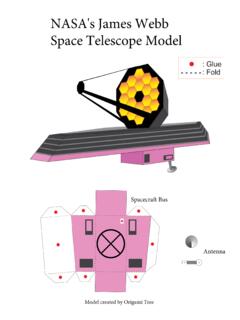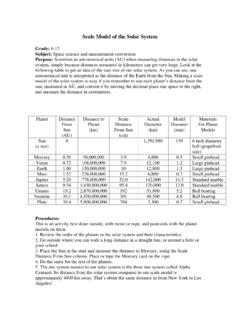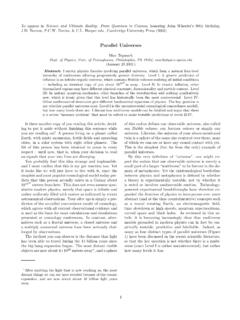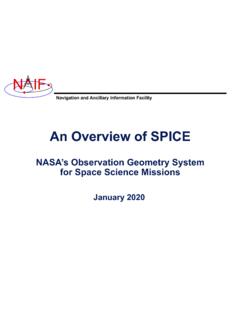Transcription of Seeking Light from the First Galaxies in the Universe NASA ...
1 NASA factsThe James Webb Space Telescope s revolutionary technology will study every phase of cosmic history from within our solar system to the most distant observable Galaxies in the early Universe . Webb s infrared telescope will explore a wide range of science questions to help us understand the origins of the Universe and our place in it. Seeking Light from the FirstGalaxies in the UniverseWebb will directly observe a part of space and time never seen before. Webb will gaze into the epoch when the very First stars and Galaxies formed, over billion years ago. Ultraviolet and visible Light emitted by the very First luminous objects has been stretched or redshifted by the Universe s continual expansion and arrives today as infrared Light . Webb is designed to see this infrared Light with unprecedented resolution and sensitivity. Exploring Distant Worldsand the solar SystemWebb will also be a powerful tool for studying the nearby Universe . Scientists will use Webb to study planets and other bodies in our solar system to determine their origin and evolution and compare them with exoplanets, planets that orbit other stars.
2 Webb will also observe exoplanets located in their stars habitable zones, the regions where a planet could harbor liquid water on its surface, and can determine if and where signatures of habitability may be present. Using a technique called transmission spectroscopy, the observatory will examine starlight filtered through planetary atmospheres to learn about their chemical FactsPRIMARY MIRROR SIZE: feet ( meters) acrossMIRROR SHAPE: The mirror is comprised of 18 gold-plated hexagonal deployable segmentsSUNSHIELD: Webb s five-layer deployable sunshield is the size of a tennis courtINSTRUMENTS: Webb has four science instruments: Near-Infrared Camera (NIRCam), Near-Infrared Spectrograph (NIRSpec), Mid-Infrared Instrument (MIRI), and Near-Infrared Imager and Slitless Spectrograph (NIRISS) with the Fine Guidance Sensor (FGS)WAVELENGTHS: Visible, Near Infrared, Mid Infrared ( micrometers)TRAVEL DISTANCE: 1 million miles ( million kilometers) from EarthLOCATION IN SPACE: Orbiting the Sun around the second Lagrange point (L2)WEBB SPACE TELESCOPEO bservatoryWebb is NASA s largest and most powerful space science telescope ever constructed.
3 Webb s enormous size and frigid operating temperature present extraordinary engineering challenges. After launching from French Guiana, the observatory will travel to an orbit about one million miles away from Earth and undergo six months of commissioning in space unfolding its mirrors, sunshield, and other smaller systems; cooling down; aligning; and calibrating. Astrono-mers worldwide will then be able to conduct scientific observations to broaden our understanding of the Universe . Webb will also comple-ment the science achieved by other NASA missions. PartnersWebb is an international collaboration between NASA and its partners, ESA (European Space Agency) and the Canadian Space Agency. Thousands of engineers and hundreds of scientists worked to make Webb a reality, along with over 300 universities, organizations, and companies from 29 states and 14 more information, visit.









